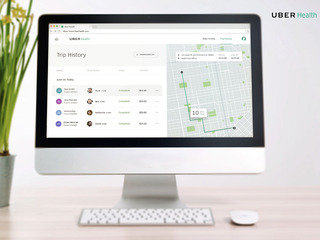

Editor’s note: Our next SplashX Invent Health, this time focused on the “Future of Clinics” is coming up on March in Palo Alto. We’ll have Patrick Carroll (Chief Medical Officer Healthcare Clinics, Walgreens), Sean Duffy (Co-Founder & CEO, Omada Health), Dave Schulte (Managing Director, McKesson Ventures), Andy Kurtzig (CEO, JustAnswer) and more. Check out the full lineup and register for tickets before they jump!
If you look at the breakdown of Uber’s demographics, the company is pretty evenly split when it comes to gender, as well as its urban versus suburban users, according to a survey done by GlobalWebIndex of over 1,300 Uber users in 2017. Where there is a big disparity, though, is in the age groups that are using it. That same survey found that the company heavily skews young, with more than half of its users under the age of 34. Those in the 55 to 64 range make up a paltry 6 percent of its total user base in the U.S.
It makes sense when you realize that older people are less likely to own a smartphone, or any kind of mobile device, for that matter, which they would need to be able to use Uber. Though the number that use smartphones is climbing, still they remain an untapped resource for the company.
Now Uber has figured out a pretty clever way of getting those people into Uber cars without even needing them to own a phone: have their doctor’s office do it for them. After all, that is the demographic that is most likely to use take advantage of the healthcare system.
On Thursday, Uber launched Uber Health, in which the company partners with healthcare organizations to shuttle patients to and from the doctor’s office. The patient doesn’t need to do anything to book the appointment or confirm the ride, as everything is done for them.
“At this point, owning a smartphone is a barrier to entry to be able to use the Uber ecosystem. This is one of the main things we’re doing to make sure that Uber is something that a broader and broader group of people can use,” Jay Holley, head of Partnerships at Uber Health, told VatorNews in an interview.
“This is something that you don’t have to have a smartphone to use it, you don’t even have to have a cellphone at all, so that opens up the world of Uber to a much broader group of people. It’s definitely something we’re very excited about and it’s a key component of what we’re putting together here.”
Uber Health is a Web-based platform, separate from the phone app, that is used only by those in the healthcare system, such as doctors, case managers, social workers, or healthcare receptionists. They can use the platform to schedule rides for patients in advance, manage all requested rides in real-time, as well as to view ride history and manage billing. Also, unlike the regular Uber app, it also allows them to have multiple rides running concurrently.
The app is also HIPPA compliant and has safety precautions built in to protect the privacy of the riders.
“The whole thing has been built from the ground up with patient privacy in mind, so everything is HIPAA compliant and partitioned away to be as respectful as possible of the patient data that comes in,” said Holley.
“We’ve gone to great lengths to make sure that, from the perspective of driver, this looks like any old, ordinary Uber trip. The driver’s not going to get any indication that it was the oncology ward that dispatched the Uber for you. From the technology layer on the back end, we have a completely separate database and a completely separate technology stack, so anything that could be considered protected health information, or any rider-level details, are completely partitioned away and are kept in fully HIPAA compliant databases to make sure we are honoring and respecting their privacy as much as we can.”
In beta since July, the company has already been working with 100 healthcare facilities including Adams Clinical, MedStar Health Institute for Innovation and Manhattan Centers for Women’s Health.
So far, Uber has found it is typically the healthcare providers who are offering this service to the patient, rather than the patient requesting it, though that could eventually change as it continues to grow.
“Very often this is used in the discharge process, so someone has had an in-patient stay or they’ve been in the doctor’s office, there might be a case manager, a social worker, a discharge planner who is working with that individual and they’ll have a conversation about their prescription, and how and when they take it, the diet they recommend that they maintain during their recovery. They’re having all those conversations anyway, and one of the conversations they’re going to have with is, ‘By the way, how are you getting home?’ And to the extent that the patient doesn’t have an answer to that question, they can offer them an Uber at that time,” Holley said.
In one case, Uber found that a doctor’s office was calling patients a few hours before their appointment to check on them to see if they needed a ride, and booking them an Uber if their plans had fallen through.
The app has also evolved throughout its beta period to accommodate the older people who are most likely to use it. One thing that the company quickly realized is that, since these patients often don’t have mobile devices, they did not have the ability to identify which car they were supposed to be riding with. In response, the company launched a paper-based solution, where it allows its users to print out a physical piece of paper that has all the information they need.
In terms of who pays for these rides, Uber bills the providers directly, and send a bill at the end of the month totaling all of the rides they provided to their patients. Insurance, at this point, is not involved in the process.
Since the facilities are willing to shell out their own dollars, then there must be a worthwhile benefit for them, the biggest one being a reduction in the amount of missed appointments, which costs the U.S. healthcare system more than $150 billion a year thanks to 3.6 million Americans who miss their schedules appointments.
“The facilities are able to mitigate the incidents of no-show. As you can imagine, it’s fairly expensive from an operational level if a hospital has a bunch of appointments scheduled and then people don’t show up for them. Even more so if it’s an out-patient surgery center, they might be doing 10 surgeries a day and if somebody misses one of those, you can imagine the cost to the business. Absolutely the goal is to make sure that people stop missing appointments,” said Holley.
“On the other side there’s certainly a patient satisfaction side of this. If somebody is at the hospital and they’re ready to get sent home, and they don’t have a convenient or reliable ride, our customers tell us it’s good business for them to help coordinate a ride home, making sure that patient has a good experience, and then, on some level, making sure that they can get that room cleaned up and let somebody who might need it a bit more use it.”
Uber’s healthcare initatives
This is not the first time that Uber has made entered into the healthcare space. It has previously delivered flu shots, driven people to get tested for diabetes and for breast cancer screenings, and provided haze masks in Singapore.
“There have been a number of things we’ve done in this space, and part of it is that Uber is able to touch so many people just based on how broad reaching our driver network is. There are cars outside of hospitals all across the country right now, even before Uber Health ever existed, and knowing we can help break down that transportation barrier and that there are people who are unable to get to their doctor just because they physically don’t have a convenient ride, it’s just seems like such an obvious place for us to step up and find a solution for them. It’s something we’ve been working on for quite some time, it is not only good for business, it’s just the right the thing to do,” Holley said.
However, he was mum on what future plans Uber might have for the healthcare space, instead focusing on what the company has been doing so far.
“Right now this has been acutely focused on making sure that the operational side of this is strong and sound, and that the technology does what it’s supposed to do. Our beta period over the course of the last eight months was 100 percent focused on ensuring that the healthcare professionals who are using this system, and the patients who are riding in these cars, and the drivers as well, are having a good experience. That has been the number one driving force behind this. We certainly have some ideas of places we can take this in the future and other things that we might be interested in doing, but as of right now, it’s just a matter of getting this first thing right.”

















